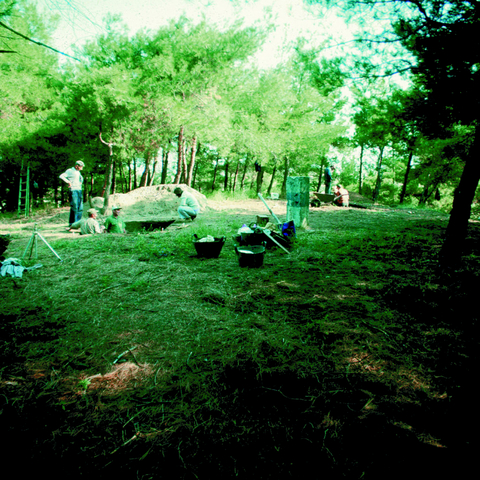The Phase 1 deposits
The reoccupation level on the summit of the mound was clearly distinguished from those which underlay it both by the character of the deposit and by the different quality of the pottery[50]. All the remains of this period were found in a generally compacted level of dark brown colour immediately below the modern surface (Fig. 2). This level seemed to be composed of decayed daub with, occasionally, the impressions of branches and twigs rather than mud brick. Some of this material seemed to have been hardened by burning, but there were only a few pieces of charcoal or the fire-reddened fragments which might be expected from a widespread destruction fire such as encountered in the lower levels. Undoubtedly humic action, ground water and weathering will have altered the character of this deposit, since it lay immediately below the surface, and in many places formed the surface level with no sign of any disturbance attributable to cultivation. The upper few cm of the stratum were treated as ʻunstratified topsoilʼ, and finds recorded separately from the remainder, but the division was often an arbitrary one. In places, ʻmodernʼ finds -cartridge cases and a coin - or finds of later periods such as Hellenistic pottery fragments- had found their way to some depth, presumably as a result of burrowing animals which have made the mound their home since its abandonment, but their presence does not materially affect the basic chronology of this final Iron Age stratum.
The pottery clearly continued the traditions of the earlier Iron Age in shape and decoration, but its distinctive character made it unmistakable and pits and other Phase 1 disturbances which cut into the underlying levels were usually easy to pick up when the sherds were strewn, even if not observed during excavation. The fabric was thinner and harder fired with a porous, even sandy surface. The decorative features such as jug necks, twisted handles and incision were usually much more sharply defined and angular. This pottery development must have taken place during the period when the Toumba was abandoned, but there is little to tell us how long this period might have been.
Although this level covered almost the whole of the summit of the mound, even in those areas where the Phase 2 strata had been eroded away during the preceding period of abandonment, it had been disturbed in many places. At some point the stone footings of the buildings had been largely quarried for use away from the Toumba, leaving only fragments of walling from which it is hard to reconstruct any coherent plan. Even so, it is possible to see that the character of the community was very different from any that preceded it. In the first stage of reoccupation a single large apsidal building dominated the summit of the mound. After an interval it was rebuilt and a second similar building constructed close beside it to the south.
The narrow gap between the two apsidal buildings at first suggested that the summit of the mound must have been crowded with buildings[51], further excavation showed that much was open yard space with smaller, apparently rectangular, structures with no consistent orientation, to the north east. Shattered pithoi were frequent, particularly in the northern apsidal building and in the area of buildings to the north east, suggesting extensive provision for storage.
Whilst two phases of construction could be distinguished in the walls and in the floors of the northern apsidal building, it was rarely possible to observe these elsewhere and it is uncertain whether any of the minor structures belonged to the first phase. It was not possible, even where two levels were found, to see any distinction between the pottery of each. The following account will therefore treat the phase as a single one, except where the evidence for two is clear. There is no obvious variation in the functional character of the pottery from one part of the site or another apart from the concentration of complete vessels in the northern apsidal building.
The date of these deposits is difficult to fix precisely, since the character of the Iron Age pottery of Central Macedonia is very conservative. There are only two fragments of painted wheel-made pottery and these suggest an eighth or seventh century date (Late Geometric or Early Archaic)[52] while the use of the apsidal building form is typical of the period. No significant pieces of charcoal were found in the deposits of this phase so unlike Phases 3 & 6 where C14 and dendrochronology have provided accurate dates[53], dating independent of pottery parallels is unavailable.
50 Pace the comments in A. Hochstetter, Kastanas: Die handgemachte Keramik 292, (Prähistorische Archäologie in Südosteuropa 3).
52 I am grateful to Prof. J.N. Coldstream for this information.
53 M. Newton, K.A. Wardle, P.I. Kuniholm, «Dendrochronology and Radiocarbon Determinations from Assiros and the Beginning of the Greek Iron Age», ΑΕΜΘ 17, 2003, 173-190.



